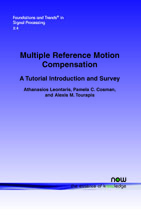Multiple Reference Motion Compensation: A Tutorial Introduction and Survey
By Athanasios Leontaris, Dolby Laboratories, Inc., USA, aleon@dolby.com | Pamela C. Cosman, Department of Electrical and Computer Engineering, University of California, USA, pcosman@ucsd.edu | Alexis M. Tourapis, Dolby Laboratories, Inc., USA, atour@dolby.com
Abstract
Motion compensation exploits temporal correlation in a video sequence to yield high compression efficiency. Multiple reference frame motion compensation is an extension of motion compensation that exploits temporal correlation over a longer time scale. Devised mainly for increasing compression efficiency, it exhibits useful properties such as enhanced error resilience and error concealment. In this survey, we explore different aspects of multiple reference frame motion compensation, including multihypothesis prediction, global motion prediction, improved error resilience and concealment for multiple references, and algorithms for fast motion estimation in the context of multiple reference frame video encoders.
Multiple Reference Motion Compensation
Motion compensation exploits temporal correlation in a video sequence to yield high compression efficiency. Multiple reference frame motion compensation is an extension of motion compensation that exploits temporal correlation over a longer time scale. Devised mainly for increasing compression efficiency, it exhibits useful properties such as enhanced error resilience and error concealment. Multiple Reference Motion Compensation: A Tutorial Introduction and Survey explores different aspects of multiple reference frame motion compensation, including multihypothesis prediction, global motion prediction, improved error resilience and concealment for multiple references, and algorithms for fast motion estimation in the context of multiple reference frame video encoders
